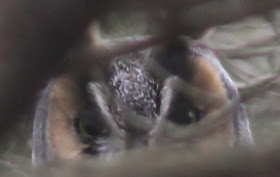Last weekend birders in Cumberland and Cape May counties took to the field in an effort to find any rare birds that may have arrived on the strong southwest and northwest winds that prevailed in the weeks prior. The date was a bit late for the ‘peak’ rarity season (usually early November) but after reading the reports from Maryland and Maine, where roundups had already occurred, how could we not join in the fun?
A little over a week ago I sent out an email probe to see who might be interested in participating and was immediately met with a few enthusiastic candidates. Clay Sutton seemed particularly excited about the prospect of coordinating Cumberland County and he immediately rallied the local troops north of the Delaware Bay shore. Down here in Cape May we had a dozen or so participants commit to covering various locations throughout the three-day weekend. While no mega rarities were found, we did turn up a few good November birds. Interestingly we dipped on Ash Throated Flycatcher for the weekend, even after one was seen just before and after the roundup weekend. Such is the world of birds.
Regardless, it was a great excuse to get out into some less-frequented habitat and see what was around. Next year we plan to hold our second annual Cape Cumberland Rarity Roundup on the weekend of 11/11/11… that date just screams rarity, does it not? Mark your calendars!
Thanks to everyone who pulled together to get this thing rolling despite all of the holiday responsibilities. For an inaugural event it was clearly a success.
Here are our highlights from the weekend (in no particular order):
SEDGE WREN – 2, possibly 3, seen at Turkey Creek (Lord, Dunne)
COMMON REDPOLL – 1 west end of Hidden Valley (Dowdell)
BLACK-LEGGED KITTIWAKE – adult flyby seen from the Hawkwatch platform at the Cape May State Park (O’Brien)
CAVE SWALLOW – seemingly everywhere during the weekend, including >70 roosting at Congress Hall in downtown Cape May
LITTLE GULL – adult flying south seen from Avalon Seawatch (Gochfeld)
GRASSHOPPER SPARROW – a late bird found in the Schellenger Tract of the Cape May National Wildlife Refuge (Reed)
ROSS’S GOOSE – Bay Point Marsh (Keller)
DICKCISSAL – Newport Landing Rd. (C & P Sutton)
Eurasian Wigeon - Lighthouse Pond, Cape May State Park (Garland)
Eurasian Wigeon - Lighthouse Pond, Cape May State Park (Garland)
Long-eared Owl – 2 in Maurice River Township (K.F. Johnson & B. Johnson)
Razorbill – Avalon Seawatch (Kolbe)
Baltimore Oriole - Singing at Higbee's (K & R Horn)
White-breasted Nuthatch – appears to be an invasion year, with several sighted on Cape Island (Elia, K & R Horn; a ‘good bird’ for the island) and many more just north of the canal in places like the Villas WMA (>12; La Puma)
Northern Goshawk – almost a regular bird this fall in Cape May, the one found over the weekend was at East Point on the Delaware Bay shore (K.F. & B. Johnson)
Marbled Godwit - 11 flying over Stone Harbor (Freiday)


















































